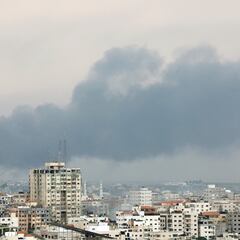Combat correspondent salaries: How much money do war zone journalists make?
Working in warzones can be as dangerous as fighting itself and many journalists have been killed in the pursuit of the truth.


The role of a journalist, in the words of George Orwell, is “printing what someone else does not want printed: everything else is public relations.”
Journalists in combat zones are the embodiment of this statement. In the maelstrom of war, journalists play a key role in showing the truth in conflicts that would otherwise be controlled by outside narratives.
Famous examples like George Steer, reporting during the Spanish Civil War, were able to break stories on horrors that would have otherwise gone unnoticed. Steer’s famous 1937 account The Tragedy of Guernica provided British readers an account of the first terror bombing in history, during the Spanish Civil War:
“In a street leading downhill from the Casa de Juntas I saw a place where 50 people, nearly all women and children, are said to have been trapped in an air raid refuge under a mass of burning wreckage,” Steer penned in The Times.
It is 84 years today since the bombing of #Guernica. Read George Steer's eyewitness report in The Times: https://t.co/8i5tMIEfh2
— Basque Children of '37 Association (@basquechildren) April 26, 2021
Steer's report had a profound impact on British public opinion and helped lead to the admission of nearly 4,000 Basque refugee children in May 1937. pic.twitter.com/BUZ1nAfXxq
“Many were killed in the fields, and altogether the deaths may run into hundreds. An elderly priest named Aronategui was killed by a bomb while rescuing children from a burning house,” he continued.
Some 90 years later and war correspondents still play this crucial role. As you might expect, it is a very dangerous business. In the following thread, Jeremy Bowen, the BBC’s Middle East editor, describe the moment a colleague was killed by an Israeli tank while the team reported in Lebanon in 2000.
20 years ago today the Israeli army killed my friend and BBC colleague Abed Takkoush in South Lebanon. They fired a tank shell into his car from their side of the border wire.They claimed we were terrorists. Abed left a wife and 3 teenage sons
— Jeremy Bowen (@BowenBBC) May 23, 2020
Bowen would describe this incident in a BBC podcast as a key turning point in having to give up frontline reporting.
War correspondents or any journalist working are unsurprisingly at increased risk of harm. In 2022, 67 journalists were killed, 50% more than the year prior. Not all of these were working in warzones but, like the quote used at the beginning of the article, putting the truth to print puts journalists in danger.
Putting this into context of 2023, Palestine is an incredibly dangerous place to be reporting. On Tuesday, four Palestinian journalists were killed in airstrikes on Gaza, the total for the last four days now at eight.
Media Coverage: "A video shows the horrific moments when Israeli fighter jets targeted the 14-storey Palestine Tower in Gaza City with a series of airstrikes while Al-Jazeera correspondent Yumna Al-Sayed was reporting live." pic.twitter.com/ZtK4arUM3b
— Quds News Network (@QudsNen) October 7, 2023
In another example closer to the US, prominent Palestinian-American journalist Shireen Abu Akleh was shot dead by an Israeli sniper last year. The killing was condemned by nearly all American news outlets but no one has been held accountable.
“I’d never seen anything like the turnout at her funeral,”said former colleague Dalia Hatuqa. “It showed how loved and respected she was. Shireen has inspired a whole generation of young women and men who admire her and her work and want to follow in her footsteps.”
In the face of death, journalists provide the world with the important perspectives of those that are the most at risk in warzones.
How much money do war correspondents make?
With all this danger you may think that war correspondents are well imbursed. However, like much of the journalism industry, workers are not well paid. One big factor in this is that international publications are less willing to pay for full time correspondents with lots of reporting delegated to freelance journalists.
“Our safety needs to be funded,” said Vaughan Smith, a former freelance video journalist and founder of the Frontline Club and the Frontline Freelance Register for freelance conflict journalists. “That cost is not being covered at the moment by an industry that has not reconciled itself with the dependence it has on freelancers.”
Related stories
There is little information online about how much war correspondents earn at present. The US Bureau of Labour Statistics notes a median salary of $55,960 for all people working in the journalist industry. Freelancers are unlikely to be paid this much, and certainly not regularly.
Let’s review. $10/word for 5,000 words (standard length for Vanity Fair) — $50,000 for one story. That’s what Michael Lewis got paid in 2007. Today that’s a sweet annual income for any freelance journalist scraping by at 50 cents a word. 🤪🤪💀
— Caitlin Kelly: writing coach/journo, RFA mentor (@CaitlinKellyNYC) October 9, 2023
Diana Kelly Levey is a freelance writer from the US. She notes on her website that the The New York Times Magazine pays between $0.50 to $2.75 per word for print and website. Wired and GQ pay between $2 to $2.75 per word. This data is from 2018 so take it with a pinch of salt; as print journalism has declined in popularity in the last five years these rates may actually be lower than higher.

